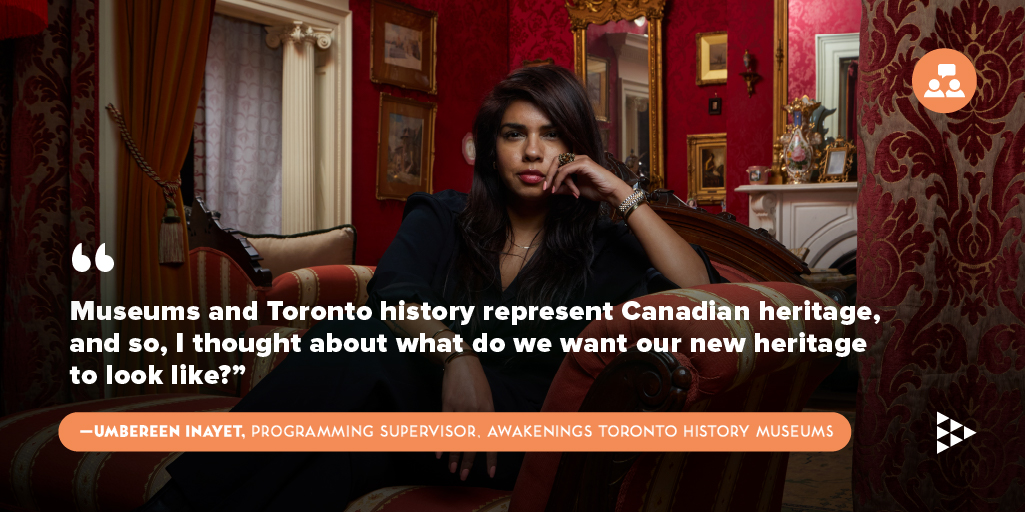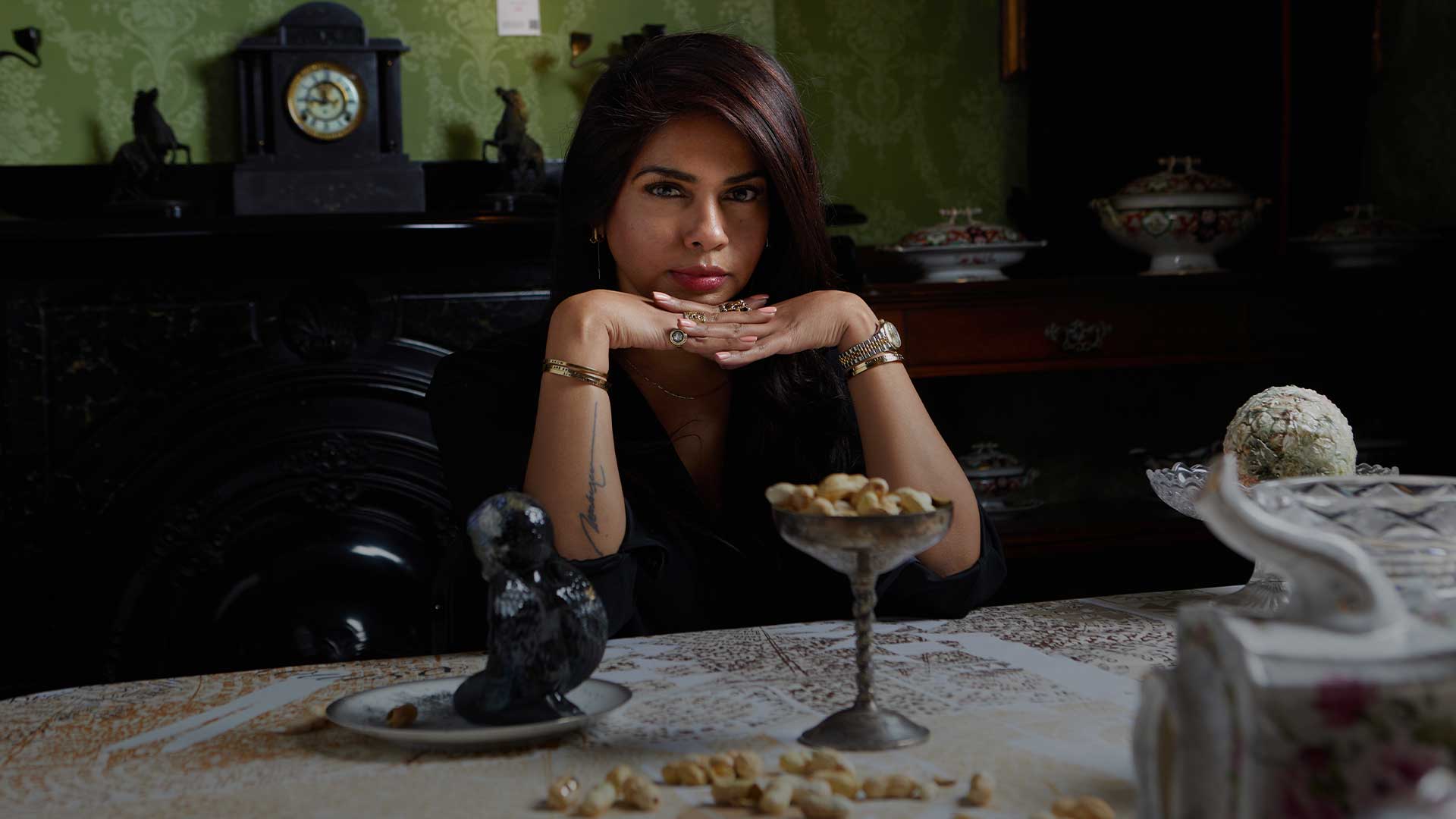With the Awakenings platform, Umbereen Inayet is leading a cultural revolution. The initiative celebrates and amplifies Black, Indigenous, artists of colour, and 2SLGBTQ+ creatives. June 2023 Update: Our interview with Umbereen focused on the Dis/Mantle…
By NowPlayingToronto
June 2023 Update: Our interview with Umbereen focused on the Dis/Mantle exhibit, which enjoyed a successful run at Spadina Museum. There are plenty of other exhibits and events to discover at Toronto History Museums. Before you start browsing, read about the importance of Dis/Mantle and watch Umbereen speak about the Awakenings platform’s contribution to the city.
The messages on the sticky notes reflected the impact Umbereen Inayet aims to have as the Programming Supervisor of Toronto History Museums’ Awakenings program. “Now you see US!!!” one read. “I commit to being uncomfortable as I un-learn + re-learn,” said another. The reflections from visitors hung on a wall near the entrance of Spadina Museum’s Black abolitionist-inspired exhibit, Dis/Mantle.
The immersive art experience, co-curated by Umbereen and lead artist Gordon Shadrach, reimagined Spadina Museum as the manor of Mrs. Louisa Pipkin. A freedom seeker from Maryland, Mrs. Pipkin escaped slavery and settled in Toronto. In the 1870s, she worked in what is now Spadina Museum as a laundress for the Austin family. But in Dis/Mantle’s Afrofuturistic narrative, Mrs. Pipkin was the home’s owner.
The walls were adorned with portraits of Mrs. Pipkin’s imagined bloodline, which included familiar faces such as Director X and members of the Toronto Raptors. Soundscapes, ceramics, and other visual art from artists of the Afro-Caribbean diaspora made the household, and its alternate history, come to life.
Dis/Mantle turned the colonial past into an experience where Black people see themselves in the city’s foundation. It was a bold narrative addressing the erasure of bloodlines, celebrating Black leadership, and honouring emancipation — all of which perfectly aligns with Umbereen’s mission with Awakenings. The City of Toronto platform, facilitated by Toronto History Museums, is supported by the Toronto Raptors organization. Through its art projects, Awakenings seeks to engage communities in anti-colonial, anti-oppression narratives and anti-racist practices.
Toronto is a city where art thrives. Check out our visual arts, media, and design listings to discover upcoming events. You can also read more about inspiring exhibits in the city — and ways to explore Toronto after you visit them — on our blog. Plus, learn about organizations in the city that uplift women in the arts.
Heading to Spadina Museum? Here’s what you need to know.
General admission to Spadina Museum, and the nine other locations that make up Toronto History Museums, is always FREE.
285 Spadina Rd.
Paid parking is available next door at Casa Loma (1 Austin Terrace) in the shared parking lot.
Hop on the Toronto Transit Commission’s Yonge-University subway line and exit at Dupont subway station. Walk north to the Baldwin Steps at the intersection of Spadina Road and Davenport Road. Spadina Museum is at the top of the Steps.
Spadina Museum offers partial accessibility. For full details, please contact the museum by calling 416-392-6910 or emailing spadina@toronto.ca.
How did Spadina Museum become Mrs. Pipkin’s Manor? Check out these behind-the-scenes facts about the exhibit.
Toronto History Museums
Mary Louisa Pipkin, the freedom seeker at the centre of Dis/Mantle, escaped enslavement in 1853 at the age of 33. She came to Toronto with her husband, Jefferson. Once here, the Pipkins worked to be united with their four enslaved children, who had been left behind in the United States. It’s not believed they were ever reunited. Mrs. Pipkin died on March 24, 1888 and was buried at Toronto’s Necropolis Cemetery.
For the exhibit, lead artist and co-curator, Gordon Shadrach, created his own interpretation of Mrs. Pipkin — complete with four monarch butterflies to represent her children. Interestingly, the Austin family, who owned the house that is now Spadina Museum, did have a portrait of Mrs. Pipkin in their home. It was the only portrait of a person of colour or a Black person that the Austins commissioned. Today, that painting is part of an Austin family descendant’s personal collection.
The co-curator and lead artist of Dis/Mantle has exhibited in solo and group art shows in Canada and the United States. Through his interest in the intersection and codification of race and fashion, Gordon creates art that disrupts the colonial constrictions of portraiture. His work invites viewers to reflect on the depiction of Black people in art and culture. Gordon is also an educator.
For months, Gordon worked on his portraits for Dis/Mantle on-location at Spadina Museum, transforming a room on the third floor into a residency studio. It gave him the opportunity to take inspiration from the surroundings and history while also intervening and challenging colonial legacies.
Toronto History Museums is a group of museums owned and operated by the City of Toronto. Focused on bringing Toronto’s history to life, they include Colborne Lodge, Fort York National Historic Site, Gibson House Museum, Mackenzie House, Market Gallery, Montgomery’s Inn, Scarborough Museum, Spadina Museum, Todmorden Mills, and Zion Schoolhouse.
Immerse yourself in the city’s history and discover surprising stories with Toronto History Museum’s self-guided walking tours. There are eight locations to choose from — including the neighbourhood around Spadina Museum. As you make your way through the tour, Toronto History Museum’s site provides historic insight at each stop.
Launched in 2020, Awakenings is part of the City of Toronto’s efforts to address anti-Black racism. More than 80 per cent of the creatives involved in Awakenings art projects are from the Black, Indigenous and people of colour communities.
For its work, Awakenings received the 2021 Lieutenant Governor’s Ontario Heritage Award for Community Leadership. In 2022, Awakenings became the only Canadian program to receive an award at the annual American Association for State and Local History conference. It earned the Award of Excellence.

Interview by: Meghan Yuri Young
Video by: Kelvin Omori and Steven Griffin
Awakenings footage provided by: Andrew Williamson Photography
Photography by: Samuel Engelking
Words by: Izabela Shubair

